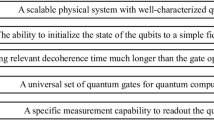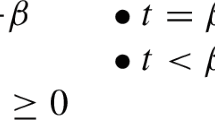Abstract
Using the notion of intuitionistic fuzzy sets, the concepts of intuitionistic fuzzy finite state machines (iffsm), intuitionistic successor s, intuitionistic subsystems, intuitionistic submachines, intuitionisticq-twins, and intuitionistic retrievable iffsm are introduce d, and related properties are studied. Relations between intuitionisticq-twins and intuitionisticq-related iffsm are given. A characterization of an intuitionistic retrievable iffsm is provided.
Similar content being viewed by others
References
K. T. Atanassov,Intuitionistic fuzzy sets, Fuzzy Sets and Systems20 (1986), 87–96.
K. T. Atanassov,New operations defined over the intuitionistic fuzzy sets, Fuzzy Sets and Systems61 (1994), 137–142.
K. T. Atanassov,Intuitionistic fuzzy sets. Theory and applications Studies in Fuzziness and Soft Computing,35, Heidelberg; Physica-Verl ag 1999.
P. Burillo and H. Bustince,Vague sets are intuitionistic fuzzy sets, Fuzzy Sets and Systems79 (1996), 403–405.
S. K. De, R. Biswas and A. R. Roy,An application of intuitionistic fuzzy sets in medical diagnosis, Fuzzy Sets and Systems117 (2001), 209–213.
L. Dengfeng and C. Chuntian,New similarity measures of intuitionistic fuzzy sets and application to pattern recognitions, Pattern Recognition Letters23 (2002), 221–225.
W. L. Gau and D. J. Buehrer,Vague sets, IEEE Trans. Systems Man Cybernet23 (1993), 610–614.
H. V. Kumbhojkar and S. R. Chaudhari,On covering of products of fuzzy finite state machines, Fuzzy Sets and Systems125 (2002), 215–222.
D. S. Malik, J. N. Mordeson and M. K. Sen,Submachines of fuzzy finite state machines, J. Fuzzy Math.2 (1994), no. 4, 781–792.
E. Szmidt and J. Kacprzyk,Entropy for intuitionistic fuzzy sets, Fuzzy Sets and Systems118 (2001), 467–477.
L. A. Zadeh,Fuzzy sets, Inform. and Control8 (1965), 338–353.
Author information
Authors and Affiliations
Corresponding author
Additional information
Y. B. Jun has been an educator and research mathematician since 1982, mostly at the Gyeongsang National University; and a member of the editorial board of Far East Journal of Mathematical Science (India) since 1998, and Quasigroups and Related Systems (Moldova) since 2000. He did postdoctoral work (one year, 1989-90, supported by KOSEF) at the University of Albert in Albert, Canada; and worked for one year (1996–97) as a visiting professor at the Northwest University in Xian, China (supported by LG Yonam Foundation). His research interests focus on the structure theory of BCK/BCI-algebras, Hilbert algebras, (lattice) implication algebras and negatively partially ordered semigroups, and fuzzy and hyper theory of such algebraic structures. Jun is a co-author of the textBCK-algebras with J Meng which is an approachable introduction to BCK/BCI-algebras.
Rights and permissions
About this article
Cite this article
Jun, Y.B. Intuitionistic fuzzy finite state machines. JAMC 17, 109–120 (2005). https://doi.org/10.1007/BF02936044
Received:
Revised:
Issue Date:
DOI: https://doi.org/10.1007/BF02936044




